Ad
Cloud Architecture - Multi Cloud, Edge, On-Premise
- 1. @arafkarsh arafkarsh ARAF KARSH HAMID Co-Founder / CTO MetaMagic Global Inc., NJ, USA @arafkarsh arafkarsh Microservice Architecture Series Building Cloud Native Apps Cloud Architecture IaaS, PaaS, SaaS, FaaS Multi / Hybrid Cloud Part 8 of 11
- 2. @arafkarsh arafkarsh Slides are color coded based on the topic colors. Cloud Adoption App Transformation 1 VMs / Containers IaaS / PaaS / SaaS / FaaS 2 Hybrid Cloud Edge Multi Cloud 3 Cloud Setup Terraform 4 2
- 3. @arafkarsh arafkarsh Agile Scrum (4-6 Weeks) Developer Journey Monolithic Domain Driven Design Event Sourcing and CQRS Waterfall Optional Design Patterns Continuous Integration (CI) 6/12 Months Enterprise Service Bus Relational Database [SQL] / NoSQL Development QA / QC Ops 3 Microservices Domain Driven Design Event Sourcing and CQRS Scrum / Kanban (1-5 Days) Mandatory Design Patterns Infrastructure Design Patterns CI DevOps Event Streaming / Replicated Logs SQL NoSQL CD Container Orchestrator Service Mesh
- 4. @arafkarsh arafkarsh Cloud Adoption • Cloud Features • Cloud Types • 6 R • Virtual Machines and Containers 4 1
- 5. @arafkarsh arafkarsh Cloud Features 5 1. Fault Tolerance 2. Scalability 3. Agility 4. Total Cost of Ownership 1. Hybrid Cloud 2. Multi Cloud
- 6. @arafkarsh arafkarsh Cloud Migration Strategies – REHOST (1 of 6) 6 ReHost Lift and Shift o Move the assets to cloud without any code change o Less Risk o No Additional Benefits other than being in Cloud Risk Benefits Costs
- 7. @arafkarsh arafkarsh Cloud Migration Strategies – REPLATFORM (2 of 6) 7 REPLATFORM / Lift & Re-Shape o Move the assets after Refactoring the assets to take advantage of cloud. Risk Benefits Costs
- 8. @arafkarsh arafkarsh Cloud Migration Strategies – REPURCHASE (3 of 6) 8 REPURCHASE / Drop & Shop o Abandon the existing feature / module and Shop for a new Service available in the Cloud o Ex. HR / CRM etc. Risk Benefits Costs
- 9. @arafkarsh arafkarsh Cloud Migration Strategies – REARCHITECT (4 of 6) 9 REARCHITECT o Redesign and transform the monolith to a Cloud Native App. Risk Benefits Costs
- 10. @arafkarsh arafkarsh Cloud Migration Strategies – RETIRE (5 of 6) 10 RETIRE o Sunset applications that are not relevant anymore. Risk Benefits Costs
- 11. @arafkarsh arafkarsh Cloud Migration Strategies – RETAIN (6 of 6) 11 RETAIN o Do Nothing approach. o Evaluate the criticality of the application later. Risk Benefits Costs
- 12. @arafkarsh arafkarsh Application Modernization – 3 Transformations 12 Monolithic SOA Microservice Physical Server Virtual Machine Cloud Waterfall Agile DevOps Source: IBM: Application Modernization > https://www.youtube.com/watch?v=RJ3UQSxwGFY Architecture Infrastructure Delivery Modernization 1 2 3
- 13. @arafkarsh arafkarsh Modernization Journey 13 Start new features as Microservices Incrementally establish the success early. Expose Legacy On-Premise Apps API’s If legacy Apps cant be shifted to Cloud Refactor Monolithic features to Microservices Breakdown and Deploy Feature by Feature Containerize the Microservice Reduce costs, simplifies the operations and consistent environment between Dev, QA and Production Monolith De-commission Plan Incrementally sunset the Monolith Velocity as you transform Increase your Delivery Velocity along the Journey High Future Present Low Inspired by a paper from IBM
- 14. @arafkarsh arafkarsh Assess and Classify your App Portfolio 14 Take inventory of your Apps Classify the Apps based on technology, complexity. Align Apps to your Business Priorities Identify the Apps that are critical for Modernization. Identify Business Modernization Requirements Create a Roadmap with faster go to market strategy Understand the effort and Cost Evaluate all possible Modernization options Container Refactor Expose APIs Lift & Shift Business Value Cost Complexity Product Catalogue Product Review Inventory Shopping Cart Customer Profile Order Management Inspired by a paper from IBM
- 15. @arafkarsh arafkarsh Summary – Cloud Adoption 15 1. Re-Host 2. Re-Platform 3. Re-Purchase 4. Re-Architect 5. Retire 6. Retain 3 Transformations
- 16. @arafkarsh arafkarsh Cloud Infrastructure • Servers / Virtual Machines / Containers • Infrastructure as a Service (IaaS) • Platform as a Service (PaaS) • Software as a Service (SaaS) • Function as a Service (FaaS) 16 2
- 17. @arafkarsh arafkarsh 17 Servers / Virtual Machines / Containers Hardware Host OS HYPERVISOR App 1 App 1 App 1 Guest OS BINS / LIB Guest OS BINS / LIB Guest OS BINS / LIB Type 2 Hypervisor App 2 App 3 App 2 OS Hardware Desktop / Laptop BINS / LIB App BINS / LIB App Container 1 Container 2 Type 1 Hypervisor Hardware HYPERVISOR App 1 App 1 App 1 Guest OS BINS / LIB Guest OS BINS / LIB Guest OS BINS / LIB App 2 App 3 App 2 Guest OS Hardware Type 1 Hypervisor BINS / LIB App BINS / LIB App BINS / LIB App Container 1 Container 2 Container 3 HYPERVISOR Virtualizes the OS Create Secure Sandboxes in OS Virtualizes the Hardware Creates Virtual Machines Hardware OS BINS / LIB App 1 App 2 App 3 Server Data Center No Virtualization Cloud Elastic Computing
- 20. @arafkarsh arafkarsh Infrastructure as a Service (IaaS) 20 Generic Compute GPU Object Storage HPC Block Storage File Storage Networking Shared Hourly / Monthly No Contracts Self Service
- 21. @arafkarsh arafkarsh IaaS – Ex. Image Processing 21 Generic Compute GPU Object Storage HPC Block Storage File Storage Networking 1. Image Stored in Object Storage 2. For Processing by different ML Algorithms Block Storage is used. 3. Once the processing is done the result is stored back in Object storage or in DB 4. Storages are attached using Networking Infrastructure.
- 22. @arafkarsh arafkarsh Infrastructure as a Service (IaaS) 22 Pros 1. Build your infra from Hours to minutes (From Weeks to Days in On-Premise Case) 2. Pay per usage (As long as infra is running) 3. Cost Effective compared to On-Premise upfront cost. Applications Data Runtime Middleware OS Virtualization Servers Storage Networking Infra as a Service Cons 1. Not As Stable as On-Premise Systems 2. Vendor Lock In
- 23. @arafkarsh arafkarsh Infrastructure as a Service (IaaS) 23 Examples 1. Amazon Web Services (AWS) 2. Microsoft Azure 3. Google Compute Engine (GCE) 4. IBM Cloud 5. Cisco Metapod 6. Digital Ocean 7. Linode 8. Rackspace Applications Data Runtime Middleware OS Virtualization Servers Storage Networking Infra as a Service
- 24. @arafkarsh arafkarsh Platform as a Service (PaaS) 24 Applications Data Runtime Middleware OS Virtualization Servers Storage Networking Platform as a Service Pros 1. Build your infra from Minutes to Seconds (From Days to Hours in On-Premise Case) 2. Easy Deployment of Applications / Services 3. You don’t have to worry about Middleware's, Runtimes etc. Cons 1. Developers are constraint to PaaS capabilities. 2. Vendor Lock In
- 25. @arafkarsh arafkarsh Platform as a Service (PaaS) 25 Applications Data Runtime Middleware OS Virtualization Servers Storage Networking PaaS Examples 1. AWS Elastic Beanstalk 2. Windows Azure 3. Heroku 4. Force.com 5. Google App Engine 6. Apache Stratos 7. K8s / OpenShift Applications Data Container K8s OS Virtualization Servers Storage Networking PaaS
- 26. @arafkarsh arafkarsh Software as a Service (SaaS) 26 Applications Data Runtime Middleware OS Virtualization Servers Storage Networking Software as a Service Pros 1. No Installation. Get Started asap. Multi Tenant 2. Accessible from Anywhere / Any Device 3. Excellent for Collaborative working 4. Cost Effective & Pay Per Usage Cons 1. Vendor Lock In. 2. Compliance Restrictions 3. Depends on Internet Speed for Performance
- 27. @arafkarsh arafkarsh Software as a Service (SaaS) 27 Applications Data Runtime Middleware OS Virtualization Servers Storage Networking Software as a Service Examples 1. Google Workspace 2. Dropbox 3. Salesforce 4. Cisco WebEx 5. Concur 6. GoToMeeting 7. Google Gmail
- 28. @arafkarsh arafkarsh Function as a Service (FaaS) 28 o Zero Hardware o Scale on Demand o Auto Scale to Zero o Cost Effective Applications Data FaaS Serverless Computing Application Deployed as small stateless functions Pay per usage Runtime Middleware OS PaaS Mins to Seconds Infra Availability Dedicated Cloud Infra Minimum Pay & Pay / Usage Virtualization Servers Storage Networking IaaS Hours to Mins Infra Availability Dedicated Cloud Infra Minimum Pay & Pay / Usage
- 29. @arafkarsh arafkarsh Function as a Service (FaaS) 29 API Gateway GET /api/customer/account POST /api/cart/add GET /api/cart/show DELETE /api/cart/delete Customer / getAccount() cart / addToCart() cart / showCart() cart / deleteCart() o Api Gateway Route the request to the function. o Function is terminated once the request is processed. In Kubernetes Knative the function will wait for few seconds before it gets terminated to see if there are any pending requests to be processed.
- 30. @arafkarsh arafkarsh Function as a Service (FaaS) 30 o Amazon Lambda o Azure Functions o Google Run (Knative) Applications Data FaaS Serverless Computing Application Deployed as small stateless functions Pay per usage Runtime Middleware OS PaaS Virtualization Servers Storage Networking IaaS
- 31. @arafkarsh arafkarsh Function as a Service (FaaS) 31 o Kubernetes Knative Kubernetes Knative is Cloud agnostic FaaS. So, No Vendor Lock-in. Applications Data FaaS Serverless Computing Application Deployed as small stateless functions Pay per usage Container K8s / Knative OS PaaS Virtualization Servers Storage Networking IaaS
- 32. @arafkarsh arafkarsh IaaS / PaaS / SaaS 32 IaaS: Lease a Car Long term usage of infrastructure, you can decide what type of infrastructure you need. More flexibility brings in more complexity. PaaS: Rent a Car You choose what’s available and pay as per your usage. SaaS: Taxi Car - Uber You don’t decide what type of car you want – you use it to accomplish the task and pay as per your usage.
- 33. @arafkarsh arafkarsh Summary of X as a Service 33 Applications Data Runtime Middleware OS Virtualization Servers Storage Networking On Premise Applications Data Runtime Middleware OS Virtualization Servers Storage Networking IaaS Applications Data Runtime Middleware OS Virtualization Servers Storage Networking SaaS Customer Managed Cloud Provider Managed Applications Data Runtime Middleware OS Virtualization Servers Storage Networking PaaS Applications Data Container K8s OS Virtualization Servers Storage Networking PaaS Applications Data Container K8s / Knative OS Virtualization Servers Storage Networking FaaS
- 34. @arafkarsh arafkarsh Cloud Types • Hybrid Cloud • Hybrid Cloud with Edge • Distributed / Multi Cloud 34 3
- 35. @arafkarsh arafkarsh On Cloud IaaS SaaS PaaS Hybrid Cloud 35 Inventory App Customer Data Financials App On Premise GDPR E-Comm Portal Notification Service Inventory App Lift & Shift Secure / Internet
- 36. @arafkarsh arafkarsh On Cloud IaaS SaaS PaaS Hybrid Cloud – Connectivity 36 Customer Data Financials App On Premise GDPR E-Comm Portal Notification Service Inventory App Lift & Shift Secure / Internet VPN Tunnel POP Point of Presence Dedicate Fiber Optic to Cloud
- 37. @arafkarsh arafkarsh On Cloud IaaS SaaS PaaS Hybrid Cloud – Service Mesh 37 Customer Data Financials App On Premise GDPR E-Comm Portal Notification Service Inventory App Lift & Shift Secure / Internet Catalogue v2 50% of traffic diverted to on Premise to v2 of Catalogue
- 38. @arafkarsh arafkarsh Hybrid Cloud with Edge 38 Customer Data Financials App On Premise GDPR On Cloud IaaS SaaS PaaS E-Comm Portal Notification Service Inventory App Lift & Shift Edge K8s K8s Delivery & Shipping
- 39. @arafkarsh arafkarsh Best Practices for Hybrid Cloud 39 On Premise / Cloud / Edge INFRASTRUCTURE Containers / Kubernetes / Linux PLATFORM Portability (Application portable across infra) Innovation (Faster GoTo Market) Security (Standardized Env across On Premise / Cloud / Edge)
- 40. @arafkarsh arafkarsh Distributed / Multi Cloud 40
- 41. @arafkarsh arafkarsh Distributed Cloud / Multi Cloud 41 Clouds Public Cloud On Premise Edge Network K8s K8s K8s Cloud On-Prem Edge DevOps o Consistent Environment o Auto Scale Across Env DevOps o Innovation o AI/ML Across All Environment DevSecOps o Governance o Security Policies o Network Policies
- 42. @arafkarsh arafkarsh Distributed Cloud / Multi Cloud 42 Clouds Public Cloud On Premise Edge Network Examples o Google Anthos o Microsoft Azure Arc Pros 1. Geography Proximity 2. Availability Across Clouds 3. Seamless Communication
- 43. @arafkarsh arafkarsh Multi cluster Single cloud Service-1 Service-2 Service-3 Service-4 Service-3 Service-4 Service-1 Service-2 Service-5 Service-6 Cluster 1 Gateway and Routing Rules Container (Pod), Deployment Strategy, Replicas Hardware Specs: Memory, CPU, GPU, QoS Service-3 Service-4 Service-1 Service-2 Service-5 Service-6 Cluster 2 Fail-over cluster (Clone Cluster 1) East-West Communication Enable Service as Serverless Gateway Secure Communication Service Definitions, Ports, Load Balancing Algo Horizontal Scaling within cluster Commit Infra Code to Service Infra Code Repository North-South Communication K8s Cluster Fail over cluster 43
- 44. @arafkarsh arafkarsh Multi cluster Single cloud Gateway Service-1 Service-2 Service-3 Service-4 Service-3 Service-4 Service-1 Service-2 Service-5 Service-6 Cluster 1 Secure Communication Container (Pod), Deployment Strategy, Replicas Hardware Specs: Memory, CPU, GPU, QoS Service-3 Service-4 Service-1 Service-2 Service-5 Service-6 Cluster 2 K8s Cluster Multi Cloud Auto Scaling (Clone Cluster 1) Commit Infra Code to Service Infra Code Repository East-West Communication Enable Service as Serverless Service Definitions, Ports, Load Balancing Algo GW GW Horizontal Scaling within cluster or across cluster Gateway and Routing Rules North-South Communication Auto Scaling across cluster 44
- 45. @arafkarsh arafkarsh Service-1 Service-2 Service-3 Service-4 Service-3 Service-4 Service-1 Service-2 Service-5 Service-6 Cluster 1 Container (Pod), Deployment Strategy, Replicas Hardware Specs: Memory, CPU, GPU, QoS Service-3 Service-4 Service-1 Service-2 Service-5 Service-6 Cluster 2 K8s Cluster Fail-over cluster (Clone Cluster 1) East-West Communication Enable Service as Serverless Gateway Secure Communication Service Definitions, Ports, Load Balancing Algo Horizontal Scaling within cluster Commit Infra Code to Service Infra Code Repository Gateway and Routing Rules North-South Communication Multi cluster Multi cloud Fail over cluster 45
- 46. @arafkarsh arafkarsh Multi cluster Multi cloud Gateway Service-1 Service-2 Service-3 Service-4 Service-3 Service-4 Service-1 Service-2 Service-5 Service-6 Cluster 1 Secure Communication Container (Pod), Deployment Strategy, Replicas Hardware Specs: Memory, CPU, GPU, QoS Service-3 Service-4 Service-1 Service-2 Service-5 Service-6 Cluster 2 K8s Cluster Multi Cloud Auto Scaling (Clone Cluster 1) Commit Infra Code to Service Infra Code Repository East-West Communication Enable Service as Serverless Service Definitions, Ports, Load Balancing Algo GW GW Horizontal Scaling within cluster or across cluster Gateway and Routing Rules North-South Communication Auto Scaling across cluster 46
- 47. @arafkarsh arafkarsh Multi cluster Multi / Hybrid / Edge cloud Gateway Service-1 Service-3 Service-6 Service-8 Service-3 Service-1 Cluster 1 Secure Communication Container (Pod), Deployment Strategy, Replicas Hardware Specs: Memory, CPU, GPU, QoS K8s Cluster Multi Cloud Auto Scaling (Clone Cluster 1) Commit Infra Code to Service Infra Code Repository Service as Serverless Service Definitions, Ports, Load Balancing Algo GW Horizontal Scaling within cluster or across cluster Gateway and Routing Rules North-South Communication Auto Scaling across cluster Service-3 Service-1 Cluster 2 GW Service-7 Service-6 Cluster 3 Service-9 Service-8 Cluster 4 On-Premise Edge 47
- 48. @arafkarsh arafkarsh Summary: Distributed Cloud / Multi Cloud 48 Clouds Public Cloud On Premise Edge Network Examples o Google Anthos o Microsoft Azure Arc Pros 1. Geography Proximity 2. Availability Across Clouds 3. Seamless Communication
- 49. @arafkarsh arafkarsh Cloud Setup • Terraform • Pulumi 49 4
- 51. @arafkarsh arafkarsh TERRAFORM INFRA CODE - AWS CLUSTER Main Code EC2 Code
- 52. @arafkarsh arafkarsh Terraform infra code – aws cluster Security Group Main
- 53. @arafkarsh arafkarsh ELB Main Route Main Terraform infra code – aws cluster
- 54. @arafkarsh arafkarsh 54 Design Patterns are solutions to general problems that software developers faced during software development. Design Patterns
- 55. @arafkarsh arafkarsh 55 DREAM | AUTOMATE | EMPOWER Araf Karsh Hamid : India: +91.999.545.8627 http://www.slideshare.net/arafkarsh https://www.linkedin.com/in/arafkarsh/ https://www.youtube.com/user/arafkarsh/playlists http://www.arafkarsh.com/ @arafkarsh arafkarsh
- 56. @arafkarsh arafkarsh 56 Source Code: https://github.com/MetaArivu Web Site: https://metarivu.com/ https://pyxida.cloud/
- 58. @arafkarsh arafkarsh References 1. July 15, 2015 – Agile is Dead : GoTo 2015 By Dave Thomas 2. Apr 7, 2016 - Agile Project Management with Kanban | Eric Brechner | Talks at Google 3. Sep 27, 2017 - Scrum vs Kanban - Two Agile Teams Go Head-to-Head 4. Feb 17, 2019 - Lean vs Agile vs Design Thinking 5. Dec 17, 2020 - Scrum vs Kanban | Differences & Similarities Between Scrum & Kanban 6. Feb 24, 2021 - Agile Methodology Tutorial for Beginners | Jira Tutorial | Agile Methodology Explained. Agile Methodologies 58
- 59. @arafkarsh arafkarsh References 1. Vmware: What is Cloud Architecture? 2. Redhat: What is Cloud Architecture? 3. Cloud Computing Architecture 4. Cloud Adoption Essentials: 5. Google: Hybrid and Multi Cloud 6. IBM: Hybrid Cloud Architecture Intro 7. IBM: Hybrid Cloud Architecture: Part 1 8. IBM: Hybrid Cloud Architecture: Part 2 9. Cloud Computing Basics: IaaS, PaaS, SaaS 59 1. IBM: IaaS Explained 2. IBM: PaaS Explained 3. IBM: SaaS Explained 4. IBM: FaaS Explained 5. IBM: What is Hypervisor? Cloud Architecture
- 60. @arafkarsh arafkarsh References Microservices 1. Microservices Definition by Martin Fowler 2. When to use Microservices By Martin Fowler 3. GoTo: Sep 3, 2020: When to use Microservices By Martin Fowler 4. GoTo: Feb 26, 2020: Monolith Decomposition Pattern 5. Thought Works: Microservices in a Nutshell 6. Microservices Prerequisites 7. What do you mean by Event Driven? 8. Understanding Event Driven Design Patterns for Microservices 60
- 61. @arafkarsh arafkarsh References – Microservices – Videos 61 1. Martin Fowler – Micro Services : https://www.youtube.com/watch?v=2yko4TbC8cI&feature=youtu.be&t=15m53s 2. GOTO 2016 – Microservices at NetFlix Scale: Principles, Tradeoffs & Lessons Learned. By R Meshenberg 3. Mastering Chaos – A NetFlix Guide to Microservices. By Josh Evans 4. GOTO 2015 – Challenges Implementing Micro Services By Fred George 5. GOTO 2016 – From Monolith to Microservices at Zalando. By Rodrigue Scaefer 6. GOTO 2015 – Microservices @ Spotify. By Kevin Goldsmith 7. Modelling Microservices @ Spotify : https://www.youtube.com/watch?v=7XDA044tl8k 8. GOTO 2015 – DDD & Microservices: At last, Some Boundaries By Eric Evans 9. GOTO 2016 – What I wish I had known before Scaling Uber to 1000 Services. By Matt Ranney 10. DDD Europe – Tackling Complexity in the Heart of Software By Eric Evans, April 11, 2016 11. AWS re:Invent 2016 – From Monolithic to Microservices: Evolving Architecture Patterns. By Emerson L, Gilt D. Chiles 12. AWS 2017 – An overview of designing Microservices based Applications on AWS. By Peter Dalbhanjan 13. GOTO Jun, 2017 – Effective Microservices in a Data Centric World. By Randy Shoup. 14. GOTO July, 2017 – The Seven (more) Deadly Sins of Microservices. By Daniel Bryant 15. Sept, 2017 – Airbnb, From Monolith to Microservices: How to scale your Architecture. By Melanie Cubula 16. GOTO Sept, 2017 – Rethinking Microservices with Stateful Streams. By Ben Stopford. 17. GOTO 2017 – Microservices without Servers. By Glynn Bird.
- 62. @arafkarsh arafkarsh References 62 Domain Driven Design 1. Oct 27, 2012 What I have learned about DDD Since the book. By Eric Evans 2. Mar 19, 2013 Domain Driven Design By Eric Evans 3. Jun 02, 2015 Applied DDD in Java EE 7 and Open Source World 4. Aug 23, 2016 Domain Driven Design the Good Parts By Jimmy Bogard 5. Sep 22, 2016 GOTO 2015 – DDD & REST Domain Driven API’s for the Web. By Oliver Gierke 6. Jan 24, 2017 Spring Developer – Developing Micro Services with Aggregates. By Chris Richardson 7. May 17. 2017 DEVOXX – The Art of Discovering Bounded Contexts. By Nick Tune 8. Dec 21, 2019 What is DDD - Eric Evans - DDD Europe 2019. By Eric Evans 9. Oct 2, 2020 - Bounded Contexts - Eric Evans - DDD Europe 2020. By. Eric Evans 10. Oct 2, 2020 - DDD By Example - Paul Rayner - DDD Europe 2020. By Paul Rayner
- 63. @arafkarsh arafkarsh References Event Sourcing and CQRS 1. IBM: Event Driven Architecture – Mar 21, 2021 2. Martin Fowler: Event Driven Architecture – GOTO 2017 3. Greg Young: A Decade of DDD, Event Sourcing & CQRS – April 11, 2016 4. Nov 13, 2014 GOTO 2014 – Event Sourcing. By Greg Young 5. Mar 22, 2016 Building Micro Services with Event Sourcing and CQRS 6. Apr 15, 2016 YOW! Nights – Event Sourcing. By Martin Fowler 7. May 08, 2017 When Micro Services Meet Event Sourcing. By Vinicius Gomes 63
- 64. @arafkarsh arafkarsh References 64 Kafka 1. Understanding Kafka 2. Understanding RabbitMQ 3. IBM: Apache Kafka – Sept 18, 2020 4. Confluent: Apache Kafka Fundamentals – April 25, 2020 5. Confluent: How Kafka Works – Aug 25, 2020 6. Confluent: How to integrate Kafka into your environment – Aug 25, 2020 7. Kafka Streams – Sept 4, 2021 8. Kafka: Processing Streaming Data with KSQL – Jul 16, 2018 9. Kafka: Processing Streaming Data with KSQL – Nov 28, 2019
- 65. @arafkarsh arafkarsh References Databases: Big Data / Cloud Databases 1. Google: How to Choose the right database? 2. AWS: Choosing the right Database 3. IBM: NoSQL Vs. SQL 4. A Guide to NoSQL Databases 5. How does NoSQL Databases Work? 6. What is Better? SQL or NoSQL? 7. What is DBaaS? 8. NoSQL Concepts 9. Key Value Databases 10. Document Databases 11. Jun 29, 2012 – Google I/O 2012 - SQL vs NoSQL: Battle of the Backends 12. Feb 19, 2013 - Introduction to NoSQL • Martin Fowler • GOTO 2012 13. Jul 25, 2018 - SQL vs NoSQL or MySQL vs MongoDB 14. Oct 30, 2020 - Column vs Row Oriented Databases Explained 15. Dec 9, 2020 - How do NoSQL databases work? Simply Explained! 1. Graph Databases 2. Column Databases 3. Row Vs. Column Oriented Databases 4. Database Indexing Explained 5. MongoDB Indexing 6. AWS: DynamoDB Global Indexing 7. AWS: DynamoDB Local Indexing 8. Google Cloud Spanner 9. AWS: DynamoDB Design Patterns 10. Cloud Provider Database Comparisons 11. CockroachDB: When to use a Cloud DB? 65
- 66. @arafkarsh arafkarsh References Docker / Kubernetes / Istio 1. IBM: Virtual Machines and Containers 2. IBM: What is a Hypervisor? 3. IBM: Docker Vs. Kubernetes 4. IBM: Containerization Explained 5. IBM: Kubernetes Explained 6. IBM: Kubernetes Ingress in 5 Minutes 7. Microsoft: How Service Mesh works in Kubernetes 8. IBM: Istio Service Mesh Explained 9. IBM: Kubernetes and OpenShift 10. IBM: Kubernetes Operators 11. 10 Consideration for Kubernetes Deployments Istio – Metrics 1. Istio – Metrics 2. Monitoring Istio Mesh with Grafana 3. Visualize your Istio Service Mesh 4. Security and Monitoring with Istio 5. Observing Services using Prometheus, Grafana, Kiali 6. Istio Cookbook: Kiali Recipe 7. Kubernetes: Open Telemetry 8. Open Telemetry 9. How Prometheus works 10. IBM: Observability vs. Monitoring 66
- 67. @arafkarsh arafkarsh References 67 1. Feb 6, 2020 – An introduction to TDD 2. Aug 14, 2019 – Component Software Testing 3. May 30, 2020 – What is Component Testing? 4. Apr 23, 2013 – Component Test By Martin Fowler 5. Jan 12, 2011 – Contract Testing By Martin Fowler 6. Jan 16, 2018 – Integration Testing By Martin Fowler 7. Testing Strategies in Microservices Architecture 8. Practical Test Pyramid By Ham Vocke Testing – TDD / BDD
- 68. @arafkarsh arafkarsh 68 1. Simoorg : LinkedIn’s own failure inducer framework. It was designed to be easy to extend and most of the important components are plug‐ gable. 2. Pumba : A chaos testing and network emulation tool for Docker. 3. Chaos Lemur : Self-hostable application to randomly destroy virtual machines in a BOSH- managed environment, as an aid to resilience testing of high-availability systems. 4. Chaos Lambda : Randomly terminate AWS ASG instances during business hours. 5. Blockade : Docker-based utility for testing network failures and partitions in distributed applications. 6. Chaos-http-proxy : Introduces failures into HTTP requests via a proxy server. 7. Monkey-ops : Monkey-Ops is a simple service implemented in Go, which is deployed into an OpenShift V3.X and generates some chaos within it. Monkey-Ops seeks some OpenShift components like Pods or Deployment Configs and randomly terminates them. 8. Chaos Dingo : Chaos Dingo currently supports performing operations on Azure VMs and VMSS deployed to an Azure Resource Manager-based resource group. 9. Tugbot : Testing in Production (TiP) framework for Docker. Testing tools
- 69. @arafkarsh arafkarsh References CI / CD 1. What is Continuous Integration? 2. What is Continuous Delivery? 3. CI / CD Pipeline 4. What is CI / CD Pipeline? 5. CI / CD Explained 6. CI / CD Pipeline using Java Example Part 1 7. CI / CD Pipeline using Ansible Part 2 8. Declarative Pipeline vs Scripted Pipeline 9. Complete Jenkins Pipeline Tutorial 10. Common Pipeline Mistakes 11. CI / CD for a Docker Application 69
- 70. @arafkarsh arafkarsh References 70 DevOps 1. IBM: What is DevOps? 2. IBM: Cloud Native DevOps Explained 3. IBM: Application Transformation 4. IBM: Virtualization Explained 5. What is DevOps? Easy Way 6. DevOps?! How to become a DevOps Engineer??? 7. Amazon: https://www.youtube.com/watch?v=mBU3AJ3j1rg 8. NetFlix: https://www.youtube.com/watch?v=UTKIT6STSVM 9. DevOps and SRE: https://www.youtube.com/watch?v=uTEL8Ff1Zvk 10. SLI, SLO, SLA : https://www.youtube.com/watch?v=tEylFyxbDLE 11. DevOps and SRE : Risks and Budgets : https://www.youtube.com/watch?v=y2ILKr8kCJU 12. SRE @ Google: https://www.youtube.com/watch?v=d2wn_E1jxn4
- 71. @arafkarsh arafkarsh References 71 1. Lewis, James, and Martin Fowler. “Microservices: A Definition of This New Architectural Term”, March 25, 2014. 2. Miller, Matt. “Innovate or Die: The Rise of Microservices”. e Wall Street Journal, October 5, 2015. 3. Newman, Sam. Building Microservices. O’Reilly Media, 2015. 4. Alagarasan, Vijay. “Seven Microservices Anti-patterns”, August 24, 2015. 5. Cockcroft, Adrian. “State of the Art in Microservices”, December 4, 2014. 6. Fowler, Martin. “Microservice Prerequisites”, August 28, 2014. 7. Fowler, Martin. “Microservice Tradeoffs”, July 1, 2015. 8. Humble, Jez. “Four Principles of Low-Risk Software Release”, February 16, 2012. 9. Zuul Edge Server, Ketan Gote, May 22, 2017 10. Ribbon, Hysterix using Spring Feign, Ketan Gote, May 22, 2017 11. Eureka Server with Spring Cloud, Ketan Gote, May 22, 2017 12. Apache Kafka, A Distributed Streaming Platform, Ketan Gote, May 20, 2017 13. Functional Reactive Programming, Araf Karsh Hamid, August 7, 2016 14. Enterprise Software Architectures, Araf Karsh Hamid, July 30, 2016 15. Docker and Linux Containers, Araf Karsh Hamid, April 28, 2015
- 72. @arafkarsh arafkarsh References 72 16. MSDN – Microsoft https://msdn.microsoft.com/en-us/library/dn568103.aspx 17. Martin Fowler : CQRS – http://martinfowler.com/bliki/CQRS.html 18. Udi Dahan : CQRS – http://www.udidahan.com/2009/12/09/clarified-cqrs/ 19. Greg Young : CQRS - https://www.youtube.com/watch?v=JHGkaShoyNs 20. Bertrand Meyer – CQS - http://en.wikipedia.org/wiki/Bertrand_Meyer 21. CQS : http://en.wikipedia.org/wiki/Command–query_separation 22. CAP Theorem : http://en.wikipedia.org/wiki/CAP_theorem 23. CAP Theorem : http://www.julianbrowne.com/article/viewer/brewers-cap-theorem 24. CAP 12 years how the rules have changed 25. EBay Scalability Best Practices : http://www.infoq.com/articles/ebay-scalability-best-practices 26. Pat Helland (Amazon) : Life beyond distributed transactions 27. Stanford University: Rx https://www.youtube.com/watch?v=y9xudo3C1Cw 28. Princeton University: SAGAS (1987) Hector Garcia Molina / Kenneth Salem 29. Rx Observable : https://dzone.com/articles/using-rx-java-observable



![@arafkarsh arafkarsh
Agile
Scrum (4-6 Weeks)
Developer Journey
Monolithic
Domain Driven Design
Event Sourcing and CQRS
Waterfall
Optional
Design
Patterns
Continuous Integration (CI)
6/12 Months
Enterprise Service Bus
Relational Database [SQL] / NoSQL
Development QA / QC Ops
3
Microservices
Domain Driven Design
Event Sourcing and CQRS
Scrum / Kanban (1-5 Days)
Mandatory
Design
Patterns
Infrastructure Design Patterns
CI
DevOps
Event Streaming / Replicated Logs
SQL NoSQL
CD
Container Orchestrator Service Mesh](https://image.slidesharecdn.com/ms-8-cloud-architecture-220104110150/85/Cloud-Architecture-Multi-Cloud-Edge-On-Premise-3-320.jpg)





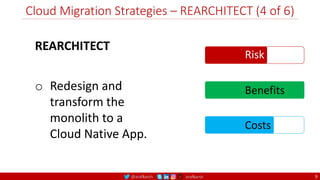



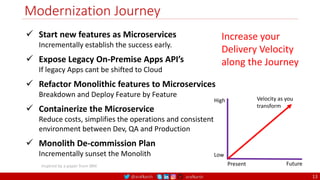


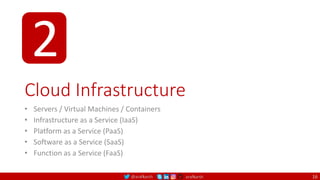





















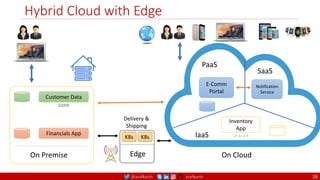
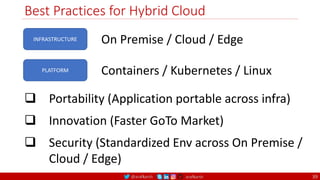











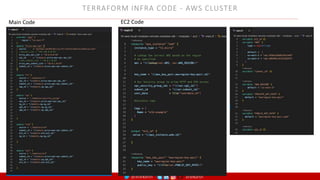


















































![[Capitole du Libre] #serverless - mettez-le en oeuvre dans votre entreprise...](https://cdn.slidesharecdn.com/ss_thumbnails/capitoledulibre2018serverless-181120135943-thumbnail.jpg?width=560&fit=bounds)

























































